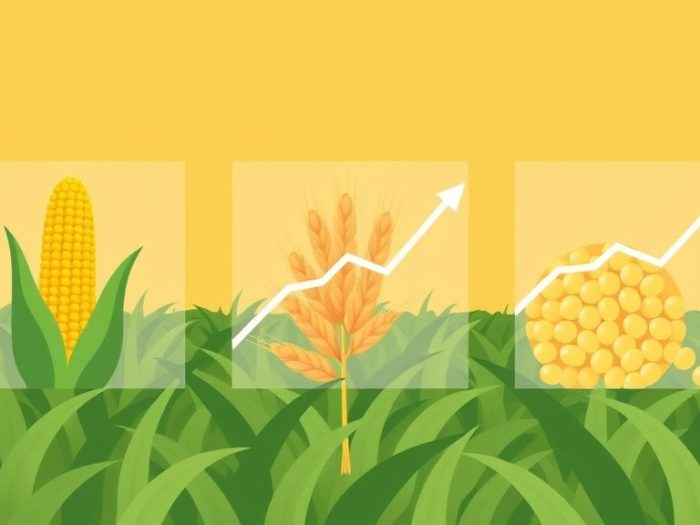Agricultural commodities play a vital role in the global economy, and their prices
can offer trading opportunities. However, the agricultural commodity market is
influenced by various factors, making it essential to choose wisely. This article
explores 5 of the best agricultural commodities to consider trading in 2025,
keeping in mind market trends and volatility.
Understanding Agricultural Commodities
Agricultural commodities are raw materials grown or raised, typically traded on
futures exchanges. Common examples include:
- Grains (corn, wheat, soybeans)
- Livestock (cattle, hogs)
- Softs (sugar, cotton, coffee)
Factors Affecting Agricultural Commodity Prices
Several factors influence the prices of agricultural commodities:
- Weather conditions
- Global demand
- Government policies
- Technological advancements
- Energy prices
5 Agricultural Commodities to Consider Trading in 2025
It’s important to note that “best” is subjective and depends on your trading
style and risk tolerance. These commodities are selected for their trading
potential and relative importance:
1. Corn
Corn is a staple crop used for food, animal feed, and ethanol production.
-
Trading Potential:
- Volatility driven by weather patterns and ethanol demand.
- High trading volume and liquidity.
-
Factors to Watch:
- US corn production and weather.
- Ethanol policies and demand.
- Global grain supply and demand.
2. Wheat
Wheat is a globally consumed grain, with price fluctuations influenced by
production in key regions.
-
Trading Potential:
- Volatility due to weather and geopolitical events.
- Global demand for food.
-
Factors to Watch:
- Production in major exporting countries (e.g., US, Russia, Ukraine).
- Global food demand and population growth.
- Geopolitical tensions affecting supply chains.
3. Soybeans
Soybeans are a versatile crop used for food, animal feed, and biodiesel.
-
Trading Potential:
- Volatility driven by weather and demand from China.
- Strong correlation with the livestock sector.
-
Factors to Watch:
- US soybean production and weather.
- Demand from China for animal feed.
- Biodiesel policies and production.
4. Cattle
Live cattle futures represent the price of live cattle for future delivery.
-
Trading Potential:
- Volatility influenced by supply and demand for beef.
- Seasonal price patterns.
-
Factors to Watch:
- Consumer demand for beef.
- Feed costs.
- Cattle supply and herd sizes.
5. Sugar
Sugar is a globally traded commodity used in food and beverages.
-
Trading Potential:
- Volatility driven by production in key regions and global consumption.
- Influence of ethanol production.
-
Factors to Watch:
- Production in Brazil and India.
- Global demand for sugar.
- Ethanol policies and demand.
Important Considerations
- Volatility: Agricultural commodities can be volatile.
- Weather: Weather events can significantly impact prices.
- Economic Factors: Global economic conditions influence demand.
- Storage and Transportation: These costs can affect prices.
-
Futures Contracts: Understand the specifications of futures
contracts.
Conclusion
Trading agricultural commodities offers opportunities, but it requires careful
analysis and risk management. Corn, wheat, soybeans, cattle, and sugar are among
the commodities worth considering in 2025. However, stay informed about the
factors influencing their prices and trade responsibly.
Related Keywords
Agricultural commodities trading, best commodities to trade, commodity futures,
corn trading, wheat trading, soybean trading, cattle trading, sugar trading,
commodity market analysis, agricultural market trends.
Frequently Asked Questions (FAQ)
1. What are agricultural commodities?
Agricultural commodities are raw materials grown or raised, such as grains, livestock, and softs, traded on futures exchanges.
2. What factors influence agricultural commodity prices?
Factors include weather conditions, global demand, government policies, technological advancements, and energy prices.
3. Why is corn a popular agricultural commodity to trade?
Corn offers volatility driven by weather and ethanol demand, along with high trading volume and liquidity.
4. What factors should I watch when trading wheat?
Watch production in major exporting countries, global food demand, and geopolitical tensions affecting supply chains.
5. What influences soybean prices?
Soybean prices are influenced by US production and weather, demand from China, and biodiesel policies.
6. What impacts cattle prices?
Cattle prices are affected by consumer demand for beef, feed costs, and cattle supply.
7. What should I be aware of when trading sugar?
Be aware of production in Brazil and India, global sugar demand, and ethanol policies.
8. Are agricultural commodities volatile?
Yes, agricultural commodities can be volatile, influenced by factors like weather and economic conditions.
9. How does weather affect agricultural commodity prices?
Weather events like droughts, floods, or freezes can significantly impact crop yields and prices.
10. Is trading agricultural commodities risky?
Yes, trading agricultural commodities involves risk. It’s essential to understand the market and manage your risk carefully.



